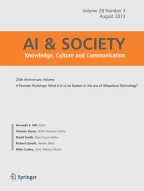Abstract
From the grotesque pavilions hidden in sixteenth century Italian gardens to the temporary structures in public space in the 70s and recent digitally augmented environments, architectures of play have long been designed to engage explorative experiences. The uncertainty of play allows us to probe new behaviors, to poke into the boundaries of subjectivity and to interact with people, things and systems in unexpected and unfamiliar ways. In this essay, we explore how an interactive system, situated in public space, may foster explorative activities and enable the transformative power of play. Through the analysis of several computer-augmented architectures, we examine what interactive qualities might enhance the transformative power of play. Beginning with the Fun Palace, an early attempt to use cybernetics in order to encourage visitors to experiment with their habits, we move to contemporary projects including some of the author’s own work. The latter takes the advantage of existing public locations in order to insert exploratory play into everyday life. Through analysis of these projects, we discuss whether such environments raise our responsibility toward others within our surroundings; whether they enable us to transform our own established behaviors; and whether they empower us to reclaim public space.
Similar content being viewed by others
Explore related subjects
Discover the latest articles, news and stories from top researchers in related subjects.Notes
Personal discussion with Roy Ascott in Vienna at Consciousness Reframed: The Planetary Collegium’s IXth International Research Conference in 2008.
Author’s personal experience of txOom installation at Biennale internazionale di Arte Giovane in Turin, Italy in 2002.
Personal discussion with one of the txOom visitors, Zurich, 2006.
References
Banham R, Barker P, Price C (1969) Non-plan: an experiment in freedom. New Soc 12(338):435–441
Barba E (1986) Beyond the floating islands. PAJ Publications, New York
Boxer S (2002) txOom: quiet an experience, Great Yarmouth, available at: http://www.futurephysical.org/pages/content/wearable/wearme/article_txoom_sb.htm. Accessed 1 Aug 2010
FoAM (ed) (2003) [tk’s:um]. Kibla, Maribor. Also: http://www.fo.am. Accessed 1 Aug 2010
Franinovic K (2005) Behavioural spaces, designing for the social and sensorial ecologies in public spaces. n: theatre, dans, etcetera. (96) pp 22–30
Franinovic K, Visell Y (2004) Recycled soundscapes. In: Proceedings of the 5th conference on designing interactive systems: processes, practices, methods, and techniques (Cambridge, MA, USA, August 01–04, 2004). DIS ‘04. ACM, New York, NY, 317
Franinovic K, Visell Y (2007) New musical interfaces in context: sonic interaction design in the urban setting. In: Proceedings of the 7th international conference on new interfaces for musical expression (New York, NY, June 06–10, 2007). NIME ‘07. ACM, New York, NY, 191–196
Franinovic K, Wilson A (2007) Hinge dimension: an exploration of enaction in architecture. In: Proceedings of the 4th international conference on enactive interfaces, pp 101–105
Goffman E (1959) The presentation of self in everyday life. Doubleday, New York
Hinge dimension comment book, in archives of essex dance (2007) Cambridge, UK. Available at http://zero-th.org/HingeDimension.html. Accessed 1 Aug 2010
Huizinga J (1986) Homo ludens: a study of the play-element in culture. Beacon Press, New York
Kuzmanovic M, Gaffney N (2005) Human-scale systems in responsive environments. IEEE Multimed 12(1):8–13
Littlewood J (1964) Fun palace: promotional brochure. Canadian Centre for Architecture. Available at http://svrdam.cca.qc.ca/ZooMI/Default.aspx?obj=DR1995:0188:001:016. Accessed 24 Aug 2010
Littlewood J, Price C (1968) The fun palace. Drama Rev 12(3):127–134
Mathews S (2007) From agit-prop to free space: the architecture of cedric price. Black Dog Publishing, London
Mauss M (1934) The technology of the body. In: Kwinter S , Crary J (eds.) (1992) Incorporations, Zone, New York, pp 455–477
Muller N (2002) Report: txOom public experiment, available at: http://libarynth.org/project_txoom_user_research. Accessed 1 Aug 2010
Pask G (1969) The architectural relevance of cybernetics. AD: architectural design (494–496)
Price C (2003) Re: CP. Birkhäuser, Basel
Schechner R (1993) The future of the ritual: writings on culture and performance. Routledge, New York
Sha XW (2002) Resistance is fertile: gesture and agency in the field of responsive media. Configurations 10(3):439–472
Sha XW (2005) The Tgarden performance research project. Mod Drama 48(3):585–608
Sterne J (2006) Urban media and the politics of sound space. In: OPEN sound: the importance of the auditory in art and the public domain, (9) (Fall 2005) pp 6–15
Turner V (1983) Brain, body and culture. Zygon 18(3):221–245
Utterbach C (2007) Artist website available at: http://www.camilleutterback.com. Accessed 1 Aug 2010
Author information
Authors and Affiliations
Corresponding author
Rights and permissions
About this article
Cite this article
Franinovic, K. Architecting play. AI & Soc 26, 129–136 (2011). https://doi.org/10.1007/s00146-010-0292-4
Received:
Accepted:
Published:
Issue Date:
DOI: https://doi.org/10.1007/s00146-010-0292-4
